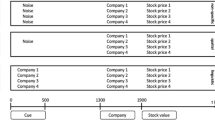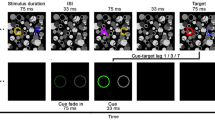Abstract
AFTER the detection of a target item in a rapid stream of visual stimuli, there is a period of 400–600 ms during which subsequent targets are missed. This impairment has been labelled the 'attentional blink'1. It has been suggested that, unlike an eye blink, the additional blink does not reflect a suppression of perceptual processing, but instead reflects a loss of information at a postperceptual stage, such as visual short-term memory2–4. Here we provide electrophysiological evidence that words presented during the attentional blink period are analysed to the point of meaning extraction, even though these extracted meanings cannot be reported 1–2 s later. This shows that the attentional blink does indeed reflect a loss of information at a postperceptual stage of processing, and provides a demonstration of the modularity of human brain function.
Similar content being viewed by others
References
Raymond, J. E., Shapiro, K. L. & Arnell, K. M. J. Exp. Psychol. Hum. Percept. Perform. 18, 849–860 (1992).
Shapiro, K. L., Raymond, J. E. & Arnell, K. M. J. Exp. Psychol. Hum. Percept. Perform. 20, 357–371 (1994).
Chun, M. M. & Potter, M. C. J. Exp. Psychol. Hum. Percept. Perform. 21, 109–127 (1995).
Shapiro, K., Driver, J., Ward, R. & Sorensen, R. E. Psychol. Sci. in the press).
Kutas, M. & Hillyard, S. A. Science 270, 203–205 (1980).
Besson, M., Kutas, M. & Van Petten, C. J. Cog. Neurosci. 4, 132–149 (1992).
Osterhout, L. & Holcomb, P. J. in Electrophysiology of Mind (eds Rugg, M. D. & Coles, M. G. H.) 171–215 (Oxford Univ. Press, New York, 1995).
Kutas, M., Van Petten, C. & Besson, M. Electroenceph. Clin. Neurophysiol. 69, 218–233 (1988).
McCarthy, G. & Nobre, A. C. Electroenceph. Clin. Neurophysiol. 88, 210–219 (1993).
Mangun, G. R., Hillyard, S. A. & Luck, S. J. in Attention and Performance XIV (eds Meyer, D. & Kornblum, S.) 219–243 (MIT Press, Cambridge, Massachusetts, 1993).
Luck, S. J. et al. J. Exp. Psychol. Hum. Percept. Perform. 20, 887–904 (1994).
Eimer, M. Percept. Psychophys. 55, 667–675 (1994).
Potter, M. C. J. Exp. Psychol. Hum. Learn. Mem. 2, 509–522 (1976).
Author information
Authors and Affiliations
Rights and permissions
About this article
Cite this article
Luck, S., Vogel, E. & Shapiro, K. Word meanings can be accessed but not reported during the attentional blink . Nature 383, 616–618 (1996). https://doi.org/10.1038/383616a0
Received:
Accepted:
Issue Date:
DOI: https://doi.org/10.1038/383616a0
- Springer Nature Limited
This article is cited by
-
Lexico-semantic Activation of Translation Equivalents During the Attentional Blink
Journal of Psycholinguistic Research (2023)
-
Combining computational controls with natural text reveals aspects of meaning composition
Nature Computational Science (2022)
-
Conscious perception of natural images is constrained by category-related visual features
Nature Communications (2019)
-
Access to consciousness of briefly presented visual events is modulated by transcranial direct current stimulation of left dorsolateral prefrontal cortex
Scientific Reports (2019)
-
The Semantic Integration Between Two Subliminally Perceived Words Simultaneously Presented at Different Locations
Journal of Psycholinguistic Research (2019)





